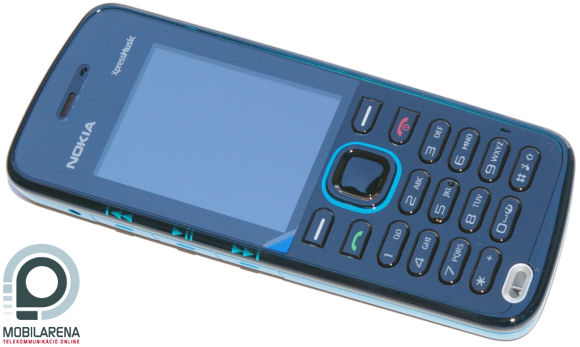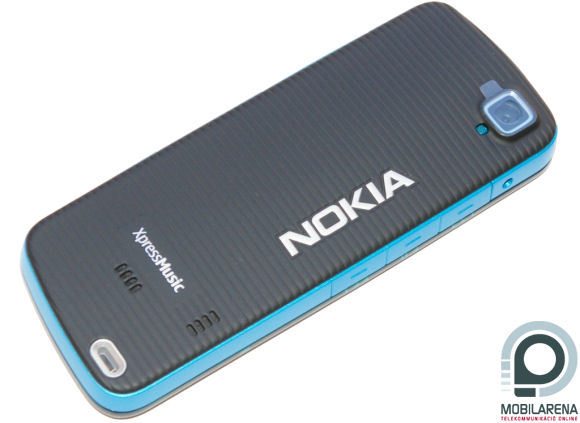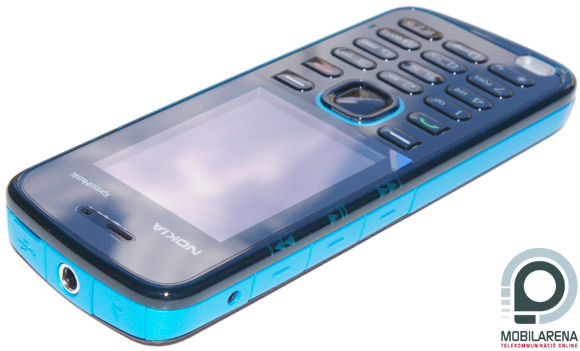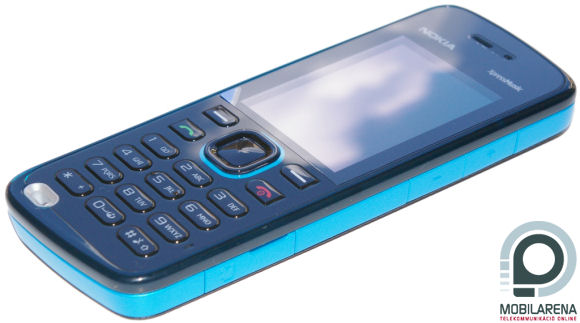Box contents, the interesting exterior
It’s been only three days since we published a review of the great Series 60 Nokia musical phone (5320 XpressMusic) and thanks to XXL GSM we have already managed to acquire 5220 XpressMusic, which, as opposed to its brother, doesn’t support N-Gage games. The reason for this is very simple: this is a low-end Series 40 phone. According to this, the handset came in a smaller box, which had a charger, a data cable, an HS-48 stereo headset (with a 3.5 mm jack plug) and a 512 MB microSD card inside.
An asymmetric cell phone. It’s strange, that’s sure, probably that’s why the market is not full of such handsets. The Finnish guys have already tried such a thing in the 7xxx series and now they have done it again, as this is one of the most cost-effective ways of launching a “unique” phone. So 5220 is deformed. A lot. On the left it’s “taller” than on the right, it looks rather strange but I can imagine this being the key to its success. Or the fact that it’s small and light, as it weighs only 78 grams, and it’s 108 x 43.5 x 10.5 mm large – I don’t know if the first number refers to the longest part or not. It’s absolutely okay from the point of view of materials used, nice plastics and precise joints are characteristic, so it’s practically better assembled than 5320, in spite of the that being a higher-quality phone.
On top of the front we can see the inevitable Nokia and XpressMusic labels, below them we can see the excellent quality QVGA display, which has a diagonal of 2”. On its left there are the three dedicated music keys, which blink according to the music’s rhythm: it’s really crappy, but it can be fortunately turned off. The keypad is below and this is the perfect opposite of the case: it’s clean, sleek, simple and easy to use. In the bottom left corner there is the neckstrap’s hook, which is practically a hole on the phone. A phone with a distorted shape and holes on it – yeah, I can really foresee it’s success.
The back is rather pleasant, it has a reticulated surface and it’s very pleasant to the touch. The 2 megapixel camera with fixed focus is in the top right corner and interestingly there is no label to advertise its qualities. Below it there’s a LED, which also blinks according to the music, it’s really needed there. On the bottom there are two other labels, the one with the manufacturer’s name is huge, the XpressMusic is smaller, but the two speakers are placed around these, thus reassuring us that the label is no trick.
The monotony of the black front and black is spiced up by the colored part running along the sides. There are three types, I had the blue one for testing. The most prominent part of the top is the 3.5 mm jack output, which is a great example for the fact that the slimness of a handset can be no reason for the lack of such a connector – as there was room for it over here too. On the right of this we can see the gap used for taking of the back cover and on the left there is the covered microUSB port. The charger’s connector is on the left, along with the three musical keys I’ve already mentioned. These are quite large so we’ll probably have no problem pressing them.
The bottom part is completely empty, while on the right there is the microSD slot and the volume control keys.
Menu, basic functions, software
Since I’ve already mentioned on the previous page, probably no one will be surprised by the fact that 5220 is based on the Series 40 platform. The current tendency shows that this system is used only on low-end or probably mid-range handsets, which is somewhat unfortunate, as probably not everyone wants to use Series 60, even in spite of the functionality and the speed. It is highly possible that many will consider switching to it, after seeing this phone, as 5220 is rather slow. Even entering submenus takes a considerable time and we can observe some lagging even when using the d-pad. This is strange since usually phones with this system are quite fast.


We won’t be discussing much about the functions of the system, since we have described these in detail in a separate article and everything is true for this phone too. Still, the extra applications are worth a note. To begin with we have a wallpaper editor, which is some rather interesting stuff: we first have to choose our preferred colors and then the software generates and abstract image that starts waving. Then we just have to press the appropriate button in the right moment and we can already set the image as a wallpaper – I just can’t imagine anyone wanting to use the program for more than half a minute, but it must be good to have. There are no other new apps, as all other ones are already familiar from previous models: Flickr, My Nokia, Opera Mini, Sensor, World clock, WidSets, Yahoo! Go. There are four games installed on the phone: City Bloxx, Guitar Rock Tour (well, if it’s a musical phone...), Rally 3D, Snake III. There is 9.2 MB of internal memory free and about 490 Mb on the memory card, as it has only four music files on it by default.


No disappointments during phone calls, sound quality was great and there were no signal problems either. We can store 2000 entries in the phonebook and there is a proper amount of extra fields for contacts. There is an e-mail client that supports authenticated IMAP servers too. The GSM module is a tri-band one (900/1800/1900 MHz) and we can use GPRS or EDGE for data transfer; there is of course no WiFi. Bluetooth is of version 2.0 and supports the stereo profile (A2DP) .
Camera and music
The camera’s resolution is 2 megapixels and has fixed focus. Highest resolution is 1600 x 1200 pixels for images and 176 x 144 for videos. Image quality is average, we have seen this image sensor in countless other Nokia models; it has the same features as ever, it’s perfect for shooting some memorable moments but we shouldn’t expect anything else. The settings are the usual: white balance, JPEG compression, effects, self-timer. Night mode is not present for some reason, but in turn we can choose between portrait and landscape view.

The phone has all the musical features that are required from an XpressMusic phone. The player can filter tracks by artist, album and genre and it also supports playlists and finds the music files on any directory on the memory card. During music playback album covers are displayed, just like all ID3 tags, there is a quick-search feature, a five-band equalizer that supports creating personal presets.


Sound quality in handsfree is average, even in spite of the two speakers, while the included HS-48 headset is rather good – by the way if we don’t like it we can switch to another one anytime, thanks to the 3.5 mm jack output. The FM radio is also present, it’s easy to use, I had absolutely no problems with it.

Battery, summary
The battery is a BL-5CT with a capacity of 1020 mAh. This is perfectly enough for such a phone, that supports only GSM networks, at an average use it had an uptime of three days.
Summary: 5220 is a fine handset, it offers exactly what has to be offered at such a price. It’s hard to write anything about the design, those will like it who prefer such an asymmetric shape, while others should avoid it. It’s quality of assembly is rather good for this category, it’s features are average and it’s perfect for listening to music. Its price is currently about €145 EUR. With such a price-tag I can’t say that it’s a best-buy, but in fact it’s not bad.
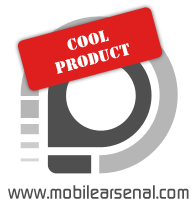 |
| Nokia 5220 XpressMusic |
Bocha
Translated by Szaszati
Nokia 5220 XpressMusic has been provided by XXL GSM. The handset can be purchased at:
Budapest VI. Jókai tér 6.
Budapest VI. Teréz körút 18.
On-line at www.xxlgsm.hu.
Specifications
| Nokia 5220 XpressMusic | ||
 | General | |
| Technology | GSM | |
| Size | 108 x 43.5 x 10.5 mm | |
| Weight | 78 grams | |
| Available colors | Blue, red, green | |
| Display | ||
| Display diagonal | 2” | |
| Display resolution | 240 x 320 pixels | |
| Display type | TFT | |
| Number of colors | 65 thousand | |
| Memory | ||
| Phonebook capacity | 2000 entries | |
| SMS memory / max. MMS size | n.a. / 300 KB | |
| Internal memory | 10 MB | |
| Memory expandability | microSD (512 MB card in package) | |
| Data transfer | ||
| Frequency bands | 900/1800/1900 MHz | |
| GPRS / EDGE | present / present | |
| UMTS / HSDPA | none / none | |
| IrDA / Bluetooth | none / 2.0 (A2DP too) | |
| WiFi | none | |
| USB | microUSB (2.0) | |
| Push-to-talk / RSS | none / none | |
| GPS receiver | none | |
| Basic functions | ||
| Profiles | present | |
| Vibra function | present | |
| Built-in handsfree | present | |
| Voice dialing / voice commands | none / none | |
| Sound recorder | present (max. 1 hour) | |
| Alarm clock | present, also when turned off | |
| Predictive text-entry | T9 | |
| Software | ||
| Platform | Series 40 5th edition | |
| WAP / HTML browser | 2.0 / present | |
| E-mail client | present (POP3, IMAP4, authenticated) | |
| Java | present, MIDP 2.0 | |
| Games | 3 | |
| Currency converter | present | |
| Extra software | Opera Mini, Wallpaper editor, Yahoo! Go, Flickr | |
| Multimedia | ||
| Main camera | 2 megapixels, fixed focus | |
| Secondary camera | none | |
| Video recording | present (176 x 144 pixels) | |
| Music player | present, can run in background | |
| Equalizer | present | |
| FM radio | present | |
| Battery | ||
| Main battery | 1020 mAh Li-Ion | |
| Standby time | 406 hours | |
| Talk time | 315 minutes | |
| Other | ||
| - | ||
